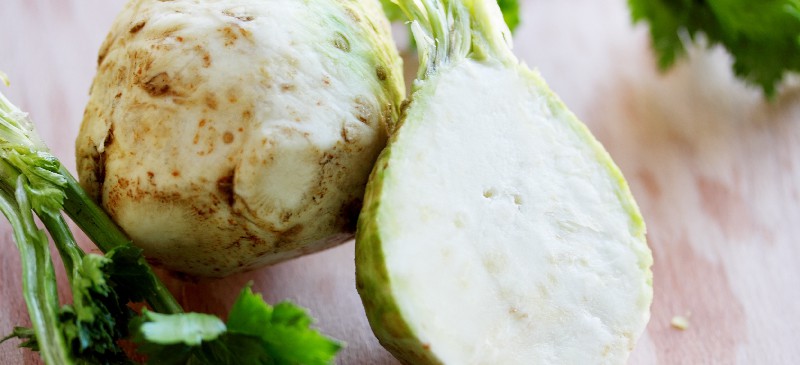
These days, you’d be hard-pressed to find someone who’s never tried celery. It is a popular ingredient often featured in low-carb, low-calorie recipes for dieters and health-conscious consumers alike. However, far less people are familiar with celeriac, a root vegetable that is closely related to celery but boasts an entirely different set of nutrients and a unique list of health benefits.
Jam-packed with fiber, vitamin K, vitamin C and antioxidants, adding celeriac to your diet can have a powerful effect on health. Plus, there are limitless ways to enjoy it. Try baking, boiling, roasting or mashing this tasty tuber to take advantage of its many potential benefits.
What Is Celeriac?
Celeriac, also known as celery root, knob celery or turnip-rooted celery, is a root vegetable that belongs to the same plant family as celery. It’s known for its distinct appearance.
This appearance features a round base with multiple knobs and protrusions. It also has a leafy top, similar to a turnip or radish.
This root vegetable is cultivated across the globe in areas like North America, Southwest Asia, North Africa and Siberia. It can be cooked or consumed raw and incorporated into a wide range of different recipes.
It’s known for its nutty, celery-like flavor, coupled with its crunchy texture and stellar nutrient profile.
In addition to being incredibly versatile, celeriac is also highly nutritious. It fact, it’s linked to a number of benefits. These include better bone health, improved blood sugar control and more.
Celeriac is believed to have originated in the Mediterranean Basin. This is the area that surrounds the Mediterranean Sea.
The root vegetable has been around for thousands of years. It was even mentioned in Homer’s epic poem “Odyssey” as “selinon.”
It remains unclear exactly when celeriac was first cultivated, but there are references to the nutritious tuber dating back to the 17th century.
Today, celeriac is grown around the world in many regions, including North America, Southwest Asia, North Africa and Siberia. However, it’s more commonly found in several specific regions and cuisines, including France and Italy. In fact, it’s a staple ingredient in céleri rémoulade, which is a type of French root salad.
Celeriac Root Benefits
Rich in important health-promoting nutrients, celeriac is used to treat a wide array of ailments in many different forms of traditional medicine.
In Ayurvedic medicine, for example, it is believed to act as a natural diuretic. It helps promote kidney function and flush out toxins.
This root vegetable also stimulates digestion and boosts energy levels. Cooked root vegetables work best for those with a vata dosha because of their grounding properties.
Meanwhile, according to Traditional Chinese Medicine, celeriac can be used to help lower blood pressure. It’s also thought to have a slightly warming effect in the body. This can promote yang energy.
It also is believed to improve conditions like constipation, diabetes, heart disease and arthritis. That’s not all.
1. Promotes Digestive Health
Celeriac is a great source of fiber, packing in nearly three grams per cup. Fiber is essential to many aspects of health. It’s especially important when it comes to digestive health.
Fiber moves slowly through the gastrointestinal tract undigested. It adds bulk to the stool to maintain regularity and promote its passage from the body.
Fiber is often used as a natural remedy for constipation. In fact, studies suggest that upping your intake of fiber can effectively increase stool frequency.
Not only that, but fiber also acts as a prebiotic. Prebiotics provide fuel for the beneficial bacteria in your gut to optimize nutrient absorption and digestion.
Plus, research shows that high-fiber foods can even benefit other conditions, like hemorrhoids, gastroesophageal reflux disease, diverticulitis and intestinal ulcers.
2. Supports Strong Bones
Although perhaps most well-known for its integral role in blood clotting, vitamin K is a micronutrient that is essential when it comes to bone health as well. Vitamin K is required for the proper function of osteocalcin. Osteocalcin is a type of protein hormone found primarily in the bone.
According to a review published in the journal Nutrition in Clinical Practice, studies show that vitamin K may help increase bone mineral density and reduce the risk of fracture.
Celeriac is one of the best sources of vitamin K available. It has about 80 percent of the daily recommended value in just one cup.
It’s also relatively high in calcium. Calciums is another key mineral required for supporting healthy bone development and metabolism.
3. Fights Free Radicals
Free radicals are harmful compounds that can build up in the body as a result of factors like stress, pollution or an unhealthy lifestyle. Over time, these compounds can take a serious toll on health.
They cause oxidative damage to the cells and even contribute to the development of chronic conditions like heart disease, cancer and diabetes.
Celeriac is rich in antioxidants. Antioxidants are powerful compounds that help fight free radicals to keep your body healthy.
Antioxidants like vitamin C can also help reduce inflammation. Inflammation plays a role in conditions like rheumatoid arthritis, leaky gut syndrome and inflammatory bowel disease.
4. Regulates Blood Sugar
Low in carbohydrates yet high in fiber, adding celeriac root to your routine is a great way to promote normal blood sugar levels. This is because fiber slows the absorption of sugar in the bloodstream. This helps prevent sudden spikes and crashes in blood sugar.
READ RELATED: 9 Standing Core Exercises That Will Fire Up Your Abs
In addition to its fiber content, celeriac is also low in calories but contains a hearty dose of protein. According to a review published in the American Journal of Clinical, following a high-protein diet can help lower blood sugar levels and improve blood sugar control. This is especially true in people with type 2 diabetes.
5. Enhances Weight Loss
Celeriac can be a delicious and nutritious addition to a well-balanced weight loss diet. Unlike many other root vegetables, it’s low in calories and carbohydrates. Plus, it’s highly versatile, adding a delicious crunch to guilt-free snacks and side dishes alike.
It’s also high in fiber and protein, both of which can be incredibly beneficial for weight loss. Fiber moves slowly through the digestive tract, helping keep you fuller for longer to ward off cravings and decrease appetite.
Meanwhile, protein helps slow the emptying of the stomach and reduces levels of ghrelin. Ghrelin is the hormone responsible for stimulating feelings of hunger.

Nutrition Facts
Celeriac root is very nutritious. It packs a good amount of vitamin K, vitamin C and phosphorus into each serving.
It’s also relatively low in celeriac carbs. Plus, it’s high in fiber. That makes it a good low-carb, healthy snack.
One cup (about 156 grams) of raw celeriac contains approximately:
- 65.5 calories
- 14.4 grams carbohydrates
- 2.3 grams protein
- 0.5 gram fat
- 2.8 grams dietary fiber
- 64 micrograms vitamin K (80 percent DV)
- 12.5 milligrams vitamin C (21 percent DV)
- 179 milligrams phosphorus (18 percent DV)
- 468 milligrams potassium (13 percent DV)
- 0.3 milligram vitamin B6 (13 percent DV)
- 0.2 milligram manganese (12 percent DV)
- 31.2 milligrams magnesium (8 percent DV)
- 67.1 milligrams calcium (7 percent DV)
- 1.1 milligrams iron (6 percent DV)
- 0.1 milligram riboflavin (6 percent DV)
- 0.1 milligram copper (5 percent DV)
- 0.5 milligram pantothenic acid (5 percent DV)
- 0.1 milligram thiamine (5 percent DV)
In addition to the nutrients listed above, this root vegetable also contains a small amount of folate, vitamin E, zinc and selenium.
Celeriac vs. Celery
Celeriac and celery are closely related. In fact, both are members of the same family of plants. They are also low in calories and carbs.
Plus, they share a refreshing, mild taste and crunchy texture. They work well when used in everything from salads to slaws.
However, despite their similar names and nutrition profiles, there are several differences between celeriac vs. celery. For starters, they have completely different appearances.
Celery is known for its bright green stalks and leafy tops. Celeriac is actually a tuber that resembles a turnip but with a more knobby, gnarled appearance.
Additionally, while both can be consumed raw or cooked, celeriac is slightly more versatile. It can be enjoyed in a myriad of soup, pasta and side dishes.
In terms of nutrition, celery has a higher water content and is significantly lower in calories and carbs. However, one cup of celeriac contains double the amount of vitamin K, four times as much vitamin C and almost twice as much fiber than a single cup of celery.
Because both bring something different to the table, you can easily enjoy both as part of a balanced, nutrient-rich diet — as well as celery seed.
How to Use (Recipes)
Wondering where to buy celeriac to start enjoying the multitude of health benefits that it has to offer? This root vegetable is widely available at most grocery stores. It can be found in the produce aisle, often in the refrigerated section.
Look for celeriac when it’s in season. That is from late fall through early winter.
The roots should be at least the size of a softball or larger. It should be firm and heavy.
Opt for organic whenever possible to minimize pesticide exposure, and store in the refrigerator to extend shelf life and longevity.
There are a number of different ways to enjoy celeriac. It can easily be consumed either raw or cooked.
Raw celeriac works well for salads or in coleslaw thanks to its slightly nutty celeriac taste and crunchy texture. It can also be boiled, mashed, roasted or baked. These options give it a slightly sweeter flavor that’s absolutely delicious.
Preparing celeriac can be a bit intimidating due to its unique appearance and gnarly protrusions. Once you get the hang of it, though, it’s actually pretty simple.
Start by cutting off the top and bottom. Then use a knife to carefully slice the rest of the skin off the veggie. Next, simply cut into slices or chunks, depending on what your specific recipe calls for.
Keep in mind that celeriac tends to lose its color quickly after it is sliced. However, you can easily prevent this by submerging it into a bowl of water with a splash of lemon juice.
There are a number of celeriac recipe options out there. These include keto fries (swap the turnips for celeriac) to celeriac puree and beyond.
Although it may not be considered a zero-carb snack since it does contain a small amount of carbs in each serving, it can be a weight loss-friendly alternative to other root vegetables in snacks, like chips or fries.
It’s also a good substitute for nightshade vegetables like potatoes or radishes for those who may have a sensitivity.
Need a few ideas for how to prep and enjoy this vegetable at home? Here are a few celeriac recipes to get you started:
Risks and Side Effects
There have been many documented reports of celeriac allergies, especially in those who are also allergic to celery or other vegetables in the same family. If you are allergic to celeriac, consuming it may lead to a slew of food allergy symptoms, including itching, tingling, swelling and dermatitis.
If you notice these or any adverse side effects after consuming celeriac, discontinue use immediately, and consider consulting with your doctor.
Final Thoughts
- What is celeriac? It is a root vegetable closely related to celery that has a round base, leafy top and crunchy texture that works well in many different celeriac recipes.
- This root vegetable is low in calories and carbohydrates. It’s also high in fiber and micronutrients like vitamin K, vitamin C, phosphorus and potassium.
- Thanks to its impressive nutrient profile and antioxidant content, some of the potential celeriac health benefits include stronger bones, enhanced digestive health, better blood sugar control and increased weight loss.
- This vegetable can be enjoyed raw or cooked. It can be included in dishes like salads, slaws, fries, veggie chips or even pastas as a delicious and nutritious addition to a well-rounded, balanced diet.
Source:








